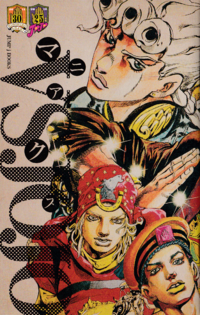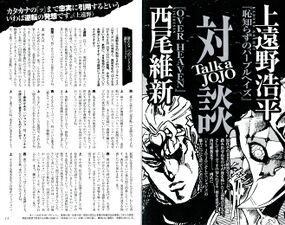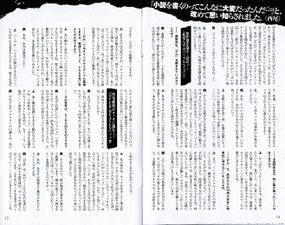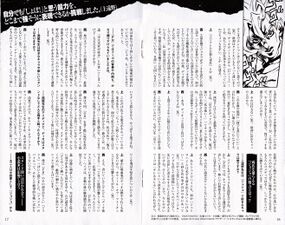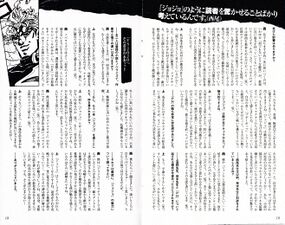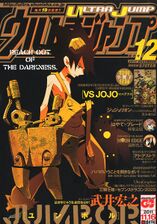VS JOJO Maniacs - Ultra Jump (November 2011)
Interview Archive
Interview with Kouhei Kadono (author of Purple Haze Feedback) and Nisio Isin (author of OVER HEAVEN), published in the "VS JOJO Maniacs" booklet. Included with the December 2011 issue of Ultra Jump released on November 19, 2011.[1]
Interview
Two new JoJo works are born!
―Congratulations to Mr. Kadono on the release of Purple Haze Feedback and to Mr. Nisio on the completion of OVER HEAVEN. To begin with, I would like to ask about Feedback, which released in September... Why did you choose Fugo to be the subject of the novel?
Kadono (K): The subject could have been anything. I thought I could tackle anything in the world of JoJo. But Fugo was convenient for the novel. I had a few other candidates in mind, but... I simply had to write about him.
Nisio (N): I'd like to hear more about those stories, too.
K: For instance, where exactly did Stroheim die in Stalingrad? (laughs) I don't know whether readers actually want that type of thing, but I enjoy the thought of it... It's a weird thing to say, but I was also thinking of using JoJo to tell a story in the style of Futaro Yamada,[a] instead of challenging Araki directly. Since it deals with Part 5, one might call it Italian Ninja Scrolls.
N: The original work's flow definitely has the atmosphere of Ninja Scrolls, doesn't it?
K: It sticks to the format of Ninja Scrolls, where the members of both teams play against each other individually. It's what they call a Jump-style presentation (laughs). And for another thing, what becomes of Fugo is simply never shown in the manga itself.
N: In the afterword of the paperback edition, Araki said, "I wanted to depict Fugo as a traitor, but in a shōnen manga whose primary audience is children, it was impossible for me to depict such a character." ...or something like that, at least.
K: When I began to actually write the novel, I got the feeling that it couldn't be a shōnen manga, because it would've been far too bleak.
N: For a start, Fugo's ability houses a homicidal virus, which is quite dangerous by itself.
K: It might've been possible in the 70s or 80s, when people were willing to put up with a little more violence.
―Was it any more difficult writing a novel based on JoJo than if you were writing an original novel?
K: Quite the opposite, actually. It was so easy to write that I rarely got stuck while developing the story, and I actually got a bit exhausted from continuously writing for so long. Maybe that's what it feels like to write as quickly as Nisio (laughs).
N: I, on the other hand, found myself struggling this time around, so I'm impressed that you were able to write so smoothly. The characters in JoJo have their own little quirks, so it's difficult to convey them very well in prose.
K: I broke all the rules in that regard, didn't I? I took various lines and scenes from the original work and wrote them directly into the text. I even faithfully reproduced the little "tsu" katakana, which is rather backwards, to say the least. So I didn't encounter any difficulty in writing what Nisio calls "JoJo-like." What I discovered while writing was that the little "tsu" is rarely used in narration and such, and it would be more JoJo-like to only use it in the dialogue. Also, in phrases like "jaa ne (ain't)," I made sure to always use the more emphatic form of "jaa," with the extra A. Really, it's all about the details.
N: No matter how hard you try to make it feel JoJo-like, there's a fine line to cross.
K: To begin with, I don't even think Araki himself knows what it means to be JoJo-like. The tension of Araki's writing style is already JoJo-like as-is. Also, readers might not pick up on this, but Feedback doesn't use the word "Stand" at all in the main text. To complement that, I went to the trouble of inserting explanations of each Stand in the spaces between chapters. There were already so many things in the work that needed an explanation, like abilities and viruses... So I decided not to explain what a Stand is.
N: That's very JoJo of you, I think.
K: I'm like Futaro Yamada in that respect. As long as it starts with "Ninjutsu," you can explain almost any strange technique.
Made with reverence to the source material... Read Purple Haze Feedback!!
―What did you think of Feedback, Mr. Nisio?
N: It was wonderful! Beyond the theme of Part 5, various elements of the original work pop up throughout the text, making it a joy to read. Usually, no one would've expected that one Stand to appear out of nowhere, would they? How did you pick which Stands would appear in the book?
K: Well, I didn't really have a choice when it came to the Part 5 characters.
N: Right. Come to think of it, most of them are dead. Those two were the only ones lucky enough to survive.
K: When I started working on the novel, I wanted an enemy character from the original work to help with the initial exposition... and they were the only ones left!
N: And those few survivors meet a much worse fate in Feedback... Also, the first line that really stuck out to me was, "The boy's name is Pannacotta Fugo." I thought to myself, "He has such a weird name, doesn't he...?" (laughs) And instead of trying to gloss over that strange name, he had his grandmother call him "Panny" to emphasize the point. I thought that was really interesting.
K: I told myself that maybe the name wasn't that strange for an Italian, and I dared to let it slide.
―Mr. Kadono, were there any scenes you were particularly engaged in while writing?
K: I think it would have to be the battle scene. I was so focused on writing it down all at once that I found myself exhausted afterward. On the other hand, the difficult part of it was the part where I quoted from the manga. Since the manga scenes casually transition to and from original scenes between them, I had a hard time connecting them together.
―You use quotes from the original work to great effect throughout Feedback.
K: From the beginning, I was determined to include the farewell scene between Fugo and Giorno's group. Without it, I had nowhere to start from. But when it came time to quote it, even though it was exactly the same as in the original, Giorno came off as a bit creepy in the novel. Maybe it's because he seems strangely calm, or maybe it's because we don't know what he's thinking. Well, in the novel, Giorno is already the reigning boss, so I gave him less dialogue to convey that impression of fear, since he was already scary enough.
N: Seeing his presence in the novel, you realize that he really is Dio's son. Also, do you like Bucciarati? He appears in Feedback quite a bit.
K: I like him, of course, but whenever Bucciarati appears, the story tightens up just a bit. A righteous character like him makes the story clearer. Personally, I see Bucciarati's role in Part 5 as "a righteous person unable to be righteous, until he meets Giorno and reaffirms his righteousness."
―Which came to you first, the story or the Stands?
K: I came up with the Stands first, but aren't the Stands already the material for the battles themselves? Especially since the main character is Purple Haze this time around, so each battle is decided by a single attack. I tried to see how much more exciting I could make each battle with clever use of the enemy's Stand. I also attempted to depict a certain change in Purple Haze itself.
N: That was the best part!
K: Purple Haze's deadly force is that of a young man when he snaps. When he loses his temper without heeding his surroundings, no one listens to him, but when he steps backs a little, a solution is born... That's the impression I got from the change I came up with.
Nisio Isin takes on Dio... OVER HEAVEN!!
K: Nisio, didn't you also finish writing your work? How did it go?
N: Like I said before, I struggled a lot. It really reminded me of just how hard it was to write a novel.
―Where did that difficulty come from?
N: It was the JoJo-like style I mentioned earlier... the JoJo-like dialogue. If I tried to write the same kind of thing myself, I would just end up with crude dialogue.
K: I don't think it's good for the writer to be too conscious of it. For my part, I decided on the characters without paying much attention to the JoJo style, and I wrote the character as if I had already decided, "This is the kind of guy I'm going to write about! I wrote the characters without being conscious of the "JoJo" style, as if I'd already decided, "Yep! This is the guy!"
N: Even so, there was no end to the number of things I had to worry about, like the tone of the character.
K: In my case, it was only to the extent that the characters would speak somewhat verbosely. For example, I would have them repeat the same word three times in the dialogue. My supervisor would read it over and ask, "Isn't this a bit too much dialogue?" But I didn't fix it (laughs). I haven't changed the novel's sense of rhythm from my usual works, though, if only because I'm not that deft. The parts that I quoted directly from the original work inherit Araki's rhythm, so there I again felt the difference between Araki's rhythm and my own.
N: For that reason, I built the story around down-to-earth language. I used Dio's Diary to Heaven as my subject, which Father Pucci gave us a glimpse of in Part 6...
K: The diary so evil that it had to be burned.
N: I wrote OVER HEAVEN to be that diary itself. So the novel itself is Dio's narrative. For the sake of maintaining that tension, I didn't have Dio write the kind of phrases you'd expect him to, like "URYYYYYYY!" (laughs) At first, I didn't quite know what to title it. Since it's Dio's diary, I thought at one point, maybe I could title it D-Note... But that'd be in bad taste, since I'm already involved with that.[b]
K: The Egypt DD Murder Cases (laughs).
N: At the beginning of Part 3, when Joseph talks about Dio after taking a photo of him, he says, "He is hiding somewhere in this world, plotting something..." That vague reason was their motivation to defeat Dio. Later, their reason for defeating Dio changed to saving Holy, but Dio's purpose and ultimate aim in gathering Stand users was never revealed. Going by his way of speaking, he aims "to stand at the pinnacle of the world," but he never mentions a clear goal in the entire story... That's what I thought at first, but then I read in Part 6 that he wanted to go to Heaven. I thought I would try to write what Dio was thinking... but that turned out to be quite a difficult task. Why did I have to choose Dio?
K: There's nothing for it (laughs). Since that premise was decided from the beginning.
N: When the project first started, I was told that I could write about anything, so I picked him. He's my favorite character in the entire story, and he has a lot of charisma as a main villain.
K: Nisio's a big fan of the strongest characters, isn't he? Even reading Medaka Box, there are a lot of characters who say things like, "I'm strong!" "I am strong!" I feel like he's continued with that style in this project. But doesn't Dio almost always lose? What do you think about that, as a fan of the strongest characters?
N: Dio really does always lose, doesn't he (laughs)?
K: He even cried when Jonathan beat him up in Part 1.
N: He always loses and never manages to achieve his goals, but why does he keep referring to himself as an emperor, and why is there no doubt in his mind? That's what I'm most intrigued by. Of course, this isn't a comedy, but rather a serious character study (laugh).
What is the charm that draws them to JoJo?!
―Who is your favorite JoJo character?
K: I like all of the main characters and allies. That's why in Feedback I didn't pick characters by prominence. I even had the Stone Mask appear as the story ramped up, even though only the oldest fans would understand it.
N: Young readers today might not even know what that is.
K: Also, Stroheim had this weird rule in his mind that "Stroheim must always declare his own name!" (laugh). That's why I picked Fugo and Purple Haze to be the main characters: not because they meant anything special to me, but because they were easier to write, like I mentioned earlier. On the other hand, I also did want to write about a young person who easily loses his temper. Fugo is described as having a short fuse, but the original story actually only had him "snap" once, so I thought, "Well, let's make that fuse even shorter."
―Fugo's background and personal life were also explored quite a bit in Feedback, weren't they?
K: I wrote something along the lines of, "Actually, my family is quite rich..." Is that alright?
N: You started by explaining Fugo's life in a basic description, and at the end you added the line, "We must have a title!" That line was very JoJo-like. I get the impression that Araki explores each character's past in order to reinforce their emotions. Maybe I could have made Dio more ambitious, too...? Well, I still have the galley proof, so I'll keep working on it until the last minute (laughs).
―Mr. Nisio, do you have a favorite character or a Stand that you would like to have?
N: I'll have to think about this one, so people don't find out I'm a slave to trends (laughs)... Generally, I'd have to answer a question like that with Rohan Kishibe's Heaven's Door. Also, Tonio's Pearl Jam. When it comes to the kinds of Stands I want, it has to be Part 4.
K: I think the fact that there's such a wide range of abilities is due to Araki's ability to take abilities that seem weak and expand them in creative ways. In this project, I challenged myself to see how much I could take abilities that I myself considered weak, like the ability to know what others have said about you behind your back, and make them stronger.
N: While writing OVER HEAVEN, I reread the original story and discovered that Dio didn't actually have a Stand when he was revived. He awakened it later with the Bow and Arrow. I wondered whether he could fight a Stand user under those conditions... but surprisingly, I think he'd actually win. Only a Stand can defeat another Stand, but with his Freezing Technique and eye beams, he can definitely defeat a Stand user (laughs).
―Going by Mr. Nisio's idea, what kinds of opponents would Dio fight without a Stand?
N: I scrapped the idea, but wasn't there the guy who had Wheel of Fortune, the guy with the car? I was thinking of a story about Dio beating him with his eye beams. Then, after he saw Dio's technique, he came up with the gasoline shooting technique he used on Jotaro and the others (laughs).
K: Being a vampire, Dio wouldn't die even if he was burned alive, so Wheel of Fortune doesn't stand a chance (laughs).
N: Right. The more I wrote, the more I thought, "Dio is just too strong!" and the more difficult it became to develop... because I did actually take it seriously while writing it, you know? Purple Haze in Feedback offered an overwhelming depiction of triumph after a tough battle.
K: If you examine the situation calmly, unexpected dangers may present themselves. That said, in order to keep readers guessing at how victory will come about, I tried to enrich the story with detailed descriptions of the adversaries and techniques only possible in the novel format.
N: I felt that part of Feedback was very JoJo-like. Battles in JoJo always have to be hopeless battles, don't they?
Stand users are drawn to each other—and novelists influence each other.
―As novelists, how has JoJo influenced the two of you?
N: There are so many things I could list, but the first that comes to mind is that a so-called "nondescript antagonist" can have one of the strongest abilities. On the other hand, Dio, the main villain, can only stop time for a few seconds (laughs). When Josuke's Crazy Diamond was first introduced, I thought, "Is this ability really suitable for the protagonist of a shōnen manga?" But that ability was awesome! In other words, even abilities that seem difficult to use at first glance can be made valuable within the story, and vice versa. I like that unexpected element in JoJo. When I read a book, I want to be surprised, and JoJo surprises me more than I could ever expect. That's why, when I write a novel or an original manga, all I can think about is surprising the reader like JoJo does.
K: For me, it's the blueprint for how to structure a conflict. Questions like, "Why are they in conflict?" This is especially true in Part 1, where both Jonathan and Dio have their own reasons to fight each other. From the protagonist's point of view, the enemy is evil, but the enemy is serious about his own life and has a good reason to fight. For that reason, if the protagonist falls short, the enemy might just eke out a win. Usually, the story is made to support the protagonist, and the enemy only exists to be defeated. In JoJo, the enemy is serious, so the protagonist needs to be serious as well. I felt that I wanted to emphasize the desperation of these characters... That said, in my own Boogiepop series, all of the antagonists stand out, and I eventually had to challenge them as well, since I couldn't just let them beat the protagonist (laughs).
―Each and every enemy in JoJo is a fascinating character in their own right, aren't they?
K: That's why I thought it was important to depict justice. In noir-type works especially, all of the bad guys tend to have vicious battles. But if your characters don't insist to each other that they embody justice, I won't be particularly excited or attracted to them. Even in a story, you can't allow evil to reign free.
―The enemies in Feedback also each had a strong presence.
K: Mr. Araki drew illustrations of the characters and Stands for me, and I find it tremendously strange. I had come up with them myself, but they no longer seemed like my own work, and I started to question whether I was describing his ideas. Could this be the power of the source material? I was also surprised and pleased that Mr. Araki was able to follow the detailed visual descriptions of the characters and Stands throughout the novel.
―Mr. Nisio, you've taken part in an interview with Mr. Araki before, haven't you?
N: I remember going on and on about how great Rock-Paper-Scissors Kid was. Come to think of it, I wonder why I was so obsessed with Rock-Paper-Scissors Kid... Surely there were other things to talk about (laughs). I believe I also said, "If I say Part 3's my favorite, people will think I'm basic, so Part 1's my favorite," and that "If I were to write a novelization, I would write about Part 2." I made that declaration so powerfully, but I forgot all about it, and here I am now writing a novel about Dio (laughs).
―Mr. Kadono, what would you do if you had the chance to talk to Mr. Araki about Feedback in the future?
K: The most I could do would be an earnest apology (laughs). "I'm so sorry." Or maybe I should talk about Rock-Paper-Scissors Kid too?
The golden future of VS JOJO!
―Do you two work on or perceive novelizations any differently, compared to your usual novels?
N: Everything is different each time I write a novel, so it was probably business as usual.
K: As I said earlier, it was really easy. I had a reference book called the source material, so it was like playing a game while looking at the strategy guide. Even if I got stuck on an idea somewhere, I had it all written down. On the contrary, I worried that I'd get too used to it (laughs).
N: People often say that when it comes to novelization, it's difficult not to destroy one's image of the original work. But for me, it was more difficult working on it on a parallel schedule to my weekly serialization. At the same time my manuscript of OVER HEAVEN was being checked, I had to come up with character names for Medaka Box. I felt trapped, but strangely enough, I also felt like the quality of both works was improving. Maybe it was the sense of crisis (laughs).
K: When you're pushed to your limit, your ability awakens, or something like that.
―If you were to write another JoJo work, what would it be about?
K: Another JoJo work... How desperate for material do you have to be (laughs)? If I had to write a second one, I'd like to base it around Josuke from Part 4. And since I have an image of Josuke as a reckless person, I'm sure the story would also turn out as reckless as possible.
N: I want to tackle JoJolion, which is currently being serialized. I wanted to publish a novelization even before the first volume released (laughs). I also want to write a story about Dio's surviving subordinate zombie from Part 2 of the series, as well as a romantic comedy about Jotaro (laughs).
K: Now that you mention it, I wonder what Mr. Otaro Maijo, who will also be writing a work after you, will center his story around. I thought I heard something about it the other day...
N: I heard about it too. I think he's got his eye on a great concept. I can't say much about it here, though.
―Finally, please tell us about the appeal of JoJo.
N: I see JoJo as a mystery. The mystery of the enemy's Stand is presented, and you have to ask how the famous Joestar family of detectives will solve it... It's a story about deducing the enemy's ability from the phenomena around it and solving its mystery. Take my word with a grain of salt, since I love mystery novels (laughs), but at the very least I find the solving of the mystery appealing.
K: JoJo is a huge mystery in and of itself, isn't it? Araki constantly challenges the readers, to see whether they can figure it out. And the mystery can never be solved! That must be the charm of it. Personally, while I didn't discover anything new while writing the novel, I feel like the depth and mystery of the work has only increased. And yet, that's what I love about it!
―Thank you very much.
新たな二つの『ジョジョ』、誕生——ッッ!!
——上遠野先生の『恥知らずのパープルヘイズ』(以下『PH』)の発売と、西尾先生の『OVER HEAVEN』(以下『OH』)の脱稿、おめでとうございます。最初に、9月発売の『PH』についてお聞きしたいのですが...なぜ題材にフーゴを選んだのですか?
上遠野 (以下、上) 題材は何でも良かったんです。『ジョジョ』の世界なら何でもできると思っていたので。ただ、フーゴだと小説にする面で、本当に都合が好かったんです。他にもいくつか候補はありましたが...これは書いても仕方ないネタばかりだったので。
西尾 (以下、西) そちらのネタも知りたいですね。
上 例えば、スターリングラードでシュトロハイムが死ぬところとか (笑)。こんなの自分が楽しいだけなので、読者が望んでいるものかどうか...。そして変な話ですけど、直球で荒木先生に真正面から勝負を挑むのではなく、『ジョジョ』を使って山田風太郎 (※注1) のような物語をやってみようという考えもあったんです。5部で「イタリアン忍法帖」というか。
西 確かに流れが『忍法帖』の雰囲気ですよね。
上 両チームが個別に対戦するという、忍法帖のフォーマットにのっとって展開させているんですよ。いわゆる「ジャンプ」的な見せ方です(笑)。あとは単純に、漫画本編にフーゴのその後が描かれていないからです。
西 荒木先生は文庫本の後書きで「フーゴは裏切り者として使うつもりだったけれど、子供たちが読む少年漫画という中で、そういった人物は描けない」...みたいな内容のことをおっしゃっていましたよね。
上 実際に小説を書いてみて、殺伐としてしまうので少年漫画にはならないと感じました。
西 そもそもフーゴって、持っている能力も「殺人ウィルス」とか、ひどく物騒ですし。
上 もう少しバイオレンスに寛容な、それこそ'70~'80年代だったらありかもしれないですけどね。
——原作がある『ジョジョ』は、オリジナル小説に比べて書きにくいものでしたか?
上 全く逆でしたね。あまりに書きやすくて、展開に詰まることもほとんどなく、むしろ書き続けたせいで体力面で消耗したくらいです。西尾さんのような、異常な筆の速さを体感したかも知れません (笑)。
西 僕は逆に今回はなかなか書けず、大変でした。だからスラッとかける上遠野さんはすごいです。『ジョジョ』の登場人物ってクセがあるので、文章にするとなかなかうまく表現できないんですよ。
上 その辺、私は完全に反則で書きましたね。原作の色々な台詞やシーンを引用して、そのまま文章にしていました。カタカナの「ッ」まで忠実に引用するという、いわば逆転の発想です。だから西尾さんのいう「『ジョジョ』っぽさ」という面では苦労はありませんでした。そして書いていて発見したのは、「ッ」は地の文ではほとんど使わず、台詞だけにした方が『ジョジョ』っぽさが引き立つんです。あと「じゃあねーよ」とか、「あ」を必ず入れるとか、本当、細かいところばかり(笑)。
西 頭で『ジョジョ』っぽくしようと意識しても、なかなか紙一重のテイストなんですよね。
上 そもそも荒木先生ご自身が「ジョジョ」っぽさを意識されているわけではないでしょうから。荒木先生のテンションが、そのまま『ジョジョ』っぽさになっているというか。あと読者はあまり気付かないかも知れませんが、実は『PH』では本文に「スタンド」という言葉は一切出していないんですよ。そしてそれを補足するために、わざわざ合間にスタンド解説を入れたりして。そもそもこの作品って「能力」とか「ウィルス」とか、本来は説明しなければならないものがいっぱいあるんですけど…敢えて「スタンドとは!?」的な説明はしないと決めたんです。
西 『ジョジョ』とはそういうものだ、と。
上 この辺は山田風太郎と一緒ですね。「忍法」と頭につけたら、大抵の不思議な技も説明がついてしまう。
原作愛を抱き…読めッ!『恥知らずのパープルヘイズ』!!
——西尾先生、『PH』を読まれていかがでしたか?
西 素晴らしかったです! しかも題材の5部に限らず、原作の色んな要素が本文中に散りばめられていて、読んでいて楽しくなります。普通、いきなりあのスタンドが出るなんて思わないじゃないですか。登場させるスタンドはどのように選んだのですか?
上 …いや、5部キャラは選択の余地がなかったので。
西 ああ、そういえばほとんど死んでいるんですよね。あのかたやあのかたが幸運で生き残っているくらいで。
上 実際に小説を書く時、序盤の説明にちょうどいい原作の敵キャラが欲しいと思ったら…こいつくらいしか残っていなかった! (笑)
西 そしてそんな数少ない生き残りが、『PH』では、さらにひどいめに…。あと、最初に刺さったのは「少年の名はパンナコッタ・フーゴ」という部分です。そういえばこいつ、こんな変な名前だったっけって (笑)。しかもその変な名前から逃げるのではなく、おばあちゃんに「パニー」と呼ばせて強調していたりして。まずそこがいきなり面白かったですね。
上 多分イタリア人にとってはそんなに変な名前じゃないのかも…と自分に言い聞かせて、あえてそのまま流しています。
——上遠野先生は、特に筆が乗ったシーンはありますか?
上 やっぱりバトルシーンかなぁ。筆が乗ったというか、集中して一気に書いてどっと疲れた感じです。逆に難しかったのは、漫画を引用する部分です。しかも途中でさりげなくオリジナルシーンに移行しているので、その繋ぎに苦心しましたね。
——『PH』は、原作からの引用が非常に効果的に使われていましたよね。
上 まず、フーゴとジョルノたちの別れのシーンだけは、絶対に入れようと決めていました。それがないと始まらない。…しかしいざ引用してみると、原作通りなのにジョルノが小説だと少し不気味に映るんですよね。妙に冷静というか、何を考えているのか分からないというか。まあ、小説でジョルノは既にボスとして君臨しているので、「これくらい怖いだろう」…と、敢えて台詞も減らして怖さを印象づけようと書いています。
西 こうして小説での貫禄を目の当りにすると、やっぱりディオの息子なんですよね。あと、上遠野さんはブチャラティはお好きなんですか?『PH』で結構出ていますが。
上 好きなのは当然ですが、ブチャラティを出すと話が締まるんです。彼のような真っ直ぐな人物は、物語を明確にしてくれる。私にとってブチャラティの5部への関わり方は、「真っ直ぐだけど、真っ直ぐになれない人物がジョルノと出会い、真っ直ぐであることを再確認する」というものだと解釈しています。
——『PH』ではオリジナルスタンドも登場しますが、物語とスタンド、どちらを先に考えられたのですか?
上 先に細かく決めていったのはスタンドですが、そもそもスタンドって戦いの内容を表すものでもありますよね。特に今回は主役がパープル・ヘイズなので、バトルだと一発で勝負がついてしまう。それをどこまで敵スタンドで盛り上げることができるのか、と工夫したつもりです。そしてパープル・ヘイズ自身にも、ある変化を描いてみました。
西 ああ、あれは最高でした!
上 パープル・ヘイズの強力すぎる力って、いわばキレる若者なんですよね。周りを見ずにキレると誰も話を聞いてくれないけど、ちょっと身を引くと解決策だって生まれる…そんな印象から思いついた変化なんです。
西尾維新がディオに挑む——『OVER HEAVEN』ッッ!!!!
上 西尾さんも作品を書き終えたんですよね。どうでしたか?
西 先ほども言いましたが、すごい苦戦しましたね。「小説を書くのってこんなに大変だったんだ…」と、今回改めて思い知らされました。
——その苦労は、どこから出たものですか?
西 先ほどお話しした『ジョジョ』っぽさ…それこそ『ジョジョ』的な台詞回しですね。自分で同じようなものを書こうとしたら、ただの品のない台詞になってしまうんです。
上 書く側が意識しすぎると駄目なんでしょうね。今回私は『ジョジョ』っぽさを意識せずにキャラクターを決めて、もう「こういう奴だ!」と決めきって書きました。
西 それでもキャラクターの口調とか、気にし始めるときりがなかったです。
上 私の場合は、キャラが多少くどく喋る程度ですね。それこそ台詞で同じ単語を3回繰り返させたり。そのせいで担当に「この台詞ってくどくないですか?」とかチェックされて。「くどいのが『ジョジョ』なんだ!」と、直しませんでしたが (笑)。ただ、小説としてのリズム感は、普段の自分の作品と変えていません。というか、少なくとも自分はそんな器用なことはできない。劇中をそのまま引用した箇所は荒木先生のリズムになっているので、そこで自分と荒木先生のリズムの違いを改めて感じました。
西 そんなわけで、僕は物語を基本は地の文で展開しています。僕は6部でプッチ神父が少しだけ語った、ディオの「天国に行くノート」を題材にしたのですが…。
上 ああ、あまりの邪悪さに燃やされたというノートですよね。
西 『OH』は、あのノートそのものを書いたんです。だから小説自体が、ディオの語りになっています。さすがにディオも文章では「~だゼェーッ!」とか「URYYYY!」とか、そこまでテンションは上がらないと思うので (笑)。最初はタイトルでもちょっと迷いましたね。ディオのノートだから『Dノート』...とか。あちらでもお仕事させてもらっているのでちょっとまずい、とか (※注2)。
上 『エジプトDD殺人事件』とか (笑)。
西 3部序盤でジョセフがディオを念写した時に語る「こいつは世界のどこかに潜んで、何かをたくらんでいる」という台詞があるんですけど...そんな曖昧な理由で彼らはディオを倒そうとしていたんですよね。その後、ディオを倒すのはホリィを助けるためという理由が固定されましたが、スタンド使いを集めて何をしようとしていたのか、ディオの目的は明かされていないんです。一応「世界の頂点に立つ」とありますが、明確な目標は本編中には語られていない...そう思っていたら、6部に「天国へ行きたい」と書かれていて。ディオが何を考えていたのか書いてみようと思ったんです...が、これはこれで、やってみるとすごい苦労で。何でディオを選んでしまったのか!
上 それは仕方ない (笑)。最初に決めちゃったんだから。
西 この企画の最初に「何でも書いていい」と言われたから、つい選んでしまったんですよ。作中で一番好きなキャラですし、ラスボスとして相当なカリスマを持っていましたから。
上 西尾さんはとにかく最強キャラが大好きですよね。『めだかボックス』を読んでも「俺は強い!」「私は強い!」ってキャラが多くて。今回の企画でそのスタイルを一貫した感じですね。...でもディオって結構負けていない? その辺は最強キャラ好きとしてどうなんですか?
西 …本当、ディオって意外と負けっぱなしなんですよね (笑)。
上 1部でジョナサンに殴られて泣いたりして。
西 この人は負けてばかりでずっと目的を達成できないでいるのに、なぜ己を「帝王」と位置づけし続けられたのか、心の迷いはなかったのか。その辺りに興味をそそられます。もちろんコメディではなく、しっかりシリアスに掘り下げています (笑)。
両氏を捕らえる『ジョジョ』の魅力とはッ!? ——上遠野先生は「ジョジョ』で好きなキャラは誰ですか?
上 メインもサブキャラも全部好きですね。だから『PH』では、キャラをランクで選ばずに出しています。勢いで石仮面まで出したけど、アレは昔からのファンしか分からないという。
西 今の若い読者はピンとこないかも知れませんよね。
上 あとシュトロハイムも、何か「シュトロハイムは必ず名前を出さないといけい!」と妙な決め事が自分の中にあって (笑)。だから主役にしたフーゴやパープル・ヘイズも決して特別扱いというのではなく、先にお話した書きやすさによる起用が大いですね。そしてその一方で、キレやすい若者を書きたいという欲求もあったんです。フーゴは「キレるキレる」と言われながら、実は原作では1回しかキレた場面が描かれていないので、「じゃあ、もっとキレさせてみよう」と。
——『PH』ではフーゴの背景や内面も、かなり掘り下げられていましたよね。
上 「実は実家が成金」とか書いてしまったけど...大丈夫なんですかね?
西 地の文でフーゴの過程を説明して、最後に台詞で「なんとしても貴族になるッ!」とか、とても『ジョジョ』っぽく感じました。そもそも荒木先生による人物背景の掘り下げって、エモーションを補強するためという印象がありますよね。僕もディオを、もっと野心的にしても良かったのかなぁ...? まぁ、まだゲラがあるのでギリギリまで調整します (笑)。
——西尾先生は好きなキャラや欲しいスタンドはありますか?
西 ミーハーがバレないように、考えて発言しないと (笑)。...大体こういう話だと岸辺露伴のヘブンズ・ドアーになります。あとトニオさんのパール・ジャムとか。こういう欲しいスタンド話になると、やっぱり4部ですね。
上 これだけ色々な能力がそろっているのも、荒木先生って「ちょっと弱くない?」と思える能力を、面白く拡大するのが驚くほど上手いからなんですよね。私は今作で「他人が過去に話した陰口が分かる」能力とか、自分でも「しょぼ!」と思う能力を、どこまで強そうに表現できるか挑戦しました。
西 僕は今回、『OH』を書く際に原作を改めて読んでみたんですけど、まずディオって復活した時はスタンドを持っていなかったんですよね。後に弓と矢で目覚めるまで。そんな状況でスタンド使いと戦えるのかと思ったら...実は意外と勝てるんですよ。スタンドはスタンドでしか倒せないけど、冷凍法とか目からビームとかで、スタンド使いは倒せる (笑)。
——西尾先生のアイディアで、ディオはスタンドなしでどんな相手と戦ったんですか?
西 没案ですけど、ホウィール・オブ・フォーチュンっていたじゃないですか、あの車の男の。ディオはあいつに目からビームで勝っちゃうという話を考えていました。で、奴はディオの技を見て、承太郎たちに使ったガソリンを飛ばす技を思いついたとか (笑)。
上 確かに吸血鬼のディオは燃やされても死なないから、ホウィール・オブ・フォーチュンごときでは勝ちようがない (笑)。
西 ええ。書いているとどんどん「ディオ強すぎる!」ってなって展開が難しくなっていく。...一応加えておきますと、ちゃんとシリアスに書いていますからね?『PH』のパープル・ヘイズは、苦戦の後の勝利描写が圧倒的でした。
上 冷静に検証していくと、実は意外と危うい部分があるかも知れません。ただ読者には「どうやって勝つんだろう」と常に思って頂くために、敵役の細かい描写や小説のテクニックで盛り上げています。
西 僕は『PH』のその部分がすごい『ジョジョ』っぽいと感じました。『ジョジョ』のバトルって、それこそ絶望的な戦いばかりじゃないですか。
スタンド使いは引かれ合う——小説家は影響し合う
——お二人は小説家として『ジョジョ』から受けた影響はありますか?
西 色々ありますが真っ先に思いつくのは、いわゆる「何でもないような敵役」が、最強に近い能力を持っていてもいいんだ!...ということです。その一方で、ラスボスのディオは時間を数秒止めるだけだったり (笑)。仗助のクレイジー・ダイヤモンドも最初、「これが少年漫画の主人公の能力でいいのだろうか?」と思いましたね。でもあの能力こそが最高だった!...つまり一見使いにくそうな能力でも、どんどん物語で価値を持たせたり、その逆もできたり。『ジョジョ』のそういう意外性が好きです。本を読むときは驚かされたい、と思うんですけれど、ジョジョは期待以上に驚かせてくれる。だから僕は小説を書くとき、あるいは漫画原作を書くとき、『ジョジョ』のように読者を驚かせることばかり考えているんです。
上 私は基本的には対立の構造の作り方ですね。「彼らはどうして対立しているのか?」とか。1部はそれが特に顕著で、ジョナサンもディオもそれぞれ対立する理由を抱いている。主人公側から見ると敵は悪ですが、敵は敵で真剣に生きていて、ちゃんと戦う理由が存在する。だから下手をすると敵が勝つこともあったりする。普通、物語はどこか主人公に都合よくできていて、敵はやられるために出てきますよね。「ジョジョ』は敵が真面目だから、主人公も真面目でなければならない。そういったキャラクターたちの必死さは大切にしたいと感じましたね。...とか言っていると、自分の書く『ブギーポップ』シリーズでも敵役ばっかりが目立って、「主人公に勝てない」とかいいながら戦いを挑むようになってしまって (笑)。
——「ジョジョ』は敵が全てキャラが立って魅力的ですよね。
上 だからこそ、やっぱり正義を描くことは大切なんだとも思いました。特にノワール系の作品とか、皆悪人ばかりで悪合戦をしがちです。でも「俺が正義だ」と主張しあってくれないと盛り上がらないし私は惹かれない。たとえ物語でも、悪さを開き直っちゃいけないんですよね。
——『PH』の敵も非常に存在感がありました。
上 荒木先生にはキャラやスタンドの絵を描いて頂いたんですが、すごい不思議な気がします。「これって荒木先生の設定を見て書いたものだっけ?」と、自分が考えたはずなのに自分のものでないような...。やっぱりこれが原作の力なんでしょうか? あと、小説の描写でキャラやスタンドのビジュアルを結構細かく書いていたんですけど、それをしっかり荒木先生が拾って下さって、それが驚きであり嬉しくもありました。
——西尾先生は以前、荒木先生と対談をされていましたよね?
西 確か「ジャンケン小僧は素晴らしい!」と延々とまくしたてていた覚えがあります。後から思い返して、なぜあそこまでジャンケン小僧にこだわったのか...もっと他に話すべきことがあっただろう、と (笑)。あと「3部が好きと言うと素人だと思われるから1部が好き」とか「ノベライズするなら2部」とか言っていましたね。あんなに力強く宣言していたのに、すっかり忘れてディオの小説を書いています (笑)。
——上遠野先生、荒木先生と『PH』について話される機会が今後あったらどうされますか?
上 もう、平謝りするしかないです (笑)。すいませんでした…って。それとも私もジャンケン小僧について語った方がいいですか?
「VS JOJO」、その黄金の未来ッッ!!
——お二人は普段の小説とノベライズで、作業や心情での違いはありますか?
西 小説を書くときは一回一回全て違いますから、むしろいつも通りだったかもしれません。
上 先ほども言いましたが、本当に楽でしたよ。全部原作という参考書があるので、攻略本を見ながらゲームするようなものです。アイディアに詰まっても全部書いていますから。逆に、これに慣れてはいけないと感じました (笑)。
西 ノベライズではよく「原作のイメージを壊さないようにすることが大変」といわれますが...それより僕は、週刊連載と同時並行のスケジュールが辛かった。『OH』では原稿をチェックしてもらっている間、『めだかボックス』のネームを描いたりしていました。それくらい追い詰められていたのですが、不思議なことに内容のクオリティは上がっていると自分でも感じました。危機感が出るんでしょうかね (笑)。
上 極限状態に追い詰められると能力が覚醒、とか。
——もし、もう一作『ジョジョ』を書くとしたら、何を書かれますか?
上 次回も『ジョジョ』とか...どれだけネタがない作家なのか(笑)。もし二作目があるなら、4部の仗助を題材にしたいですね。しかも私は仗助に対してちゃらんぽらんなイメージがあるので、話もきっとちゃらんぽらんにすると思います。
西 僕は連載中の『ジョジョリオン』がやりたいです。単行本1巻が出る前にノベライズを出したかった (笑)。あとはディオの部下で2部に生き残っていたゾンビの話とか、承太郎のラブコメ話とか (笑)。
上 そうなってくると、この後作品を書かれ舞城王太郎先生の題材が気になりますね。この前ちょっと小耳に挟みましたが...。
西 僕もちらっと聞きました。凄いところに目をつけてくるなぁ! ...と思いました。とてもこの場では言えませんが。
——それでは最後に、『ジョジョ』の魅力について語って下さい。
西 僕は『ジョジョ』をミステリーとして読んでいるところがあります。敵スタンドという謎が提示されて、名探偵ジョースター一族はそれをどう攻略するか...現象から敵の能力を推理して、それを解決する物語なんだ、と。推理小説好きの発言ですから鵜呑みにはできませんが(笑)、少なくとも僕が魅力を感じているのはその『謎解き』ですね。
上 『ジョジョ』はシリーズそのものが巨大なミステリーなんですよね。読者がそれを攻略できるか、常に荒木先生による挑戦が続けられていて...。そしてその謎は絶対に解けない!それが魅力でしょうね。私自身、実際に小説を書いてみての新発見はありませんでしたが、作品の深みや謎ばかりが増えた気がしています。でも、そこがたまらない!
——ありがとうございました。
注1) 1940年代にデビューし、推理小説・伝奇小説・歴史小説など多数の娯楽作品を発表してきた小説家。奔放な発想で忍者たちの戦いを描いた「忍法帖シリーズ」は特に人気が高く、幾度となく漫画化・映像化されている。
注2) 西尾先生が2006年に、『DEATH NOTE』(大場つぐみ・小畑健/週刊少年ジャンプ連載)のノベライズを手掛けたことを受けての発言。ちなみにタイトルは『DEATH NOTEアナザーノートロサンゼルスBB連続殺人事件』。
Notes
- ↑ Futaro Yamada is a novelist who made his debut in the 1940s. He has written works in many genres, including mystery, biographical, and historical novels. His Ninja Scrolls series, which depicts the battles of ninjas with unrestrained ideas, is particularly popular and has been adapted into manga and film several times.
- ↑ Mr. Nisio made this statement in reference to his 2006 novelization of Death Note, a manga by Tsugumi Ohba and Takeshi Obata serialized in Weekly Shonen Jump. Incidentally, the title of the novelization is Death Note Another Note: The Los Angeles BB Murder Cases.
